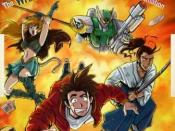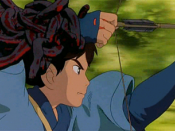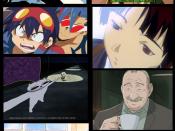Anime, the cartoon style with no boundaries Anime goes beyond boundaries, comes alive, in the art and situations, and has a wide range of genres for everyone. Anime put simply is Japanese cartoons. Manga, which began before anime, is the comic book form of anime. "If you want to see a story told just as fast as the most exciting comic book, but with amazing movement, music, and dialogue, that's what you get from anime"� (Corliss, 1). The characters in anime have exaggerated features that make anime more interesting artistically, while revealing definite exaggerated expressions. The art in anime doesn't exist just in the characters; every aspect, especially backgrounds, have an artistic edge. American cartoon industries avoid the complex art in the background because it costs more than they want to spend. The plots in anime never have a distinct structure, but most unfold in a complex manner that reflects the real world.
Anime cannot be classified in any certain group because the topics expand to so many types, genres, and ages. Anime doesn't have the Disney convention, such as the happy ending, the kissing scene, and the funny-animal creatures. Anime takes cartoons and art one step beyond.
The history of anime began with a few small manga artists, which progressed slowly over the years. "The first three Japanese cartoons were one-reelers of one to five minutes each, in 1917... A few [later ones] were imitations of foreign cartoons, such as the Felix the Cat series, but most were dramatizations of Oriental folk tales in traditional Japanese art styles"� (Patten, 1). "Animation returned to the individual filmmakers right after WWII, they hampered for the next decade by the slow recovery of the Japanese economy"� (Patten, 2). These cartoons often depicted war, other anime makers based theirs off of old folklore, and other animators used Disney-like approaches. One man, Osama Tezuka, wrote a successful novel-length manga book at the age of twenty deeming him the "God of Manga"�. "Tezuka's illustrations exploded with action and emotion"� (O'Connell, 1), and contributed much to what anime characters look like now with round heads and expressive eyes from Disney cartoons. Manga led to anime, anime went onto film, then animation companies and film studios, which then developed anime television series and full motion pictures with computer aid. The release of Akira, a very successful anime, paved the way for an anime market. Ghost in the Shell, another sci-fi flick, used integrated cell animation with computer graphics and placed number one on the Billboards Top Videos Sales Chart. Several shows started such as Dragon Ball Z, Speed Racer, Sailormoon, and Pokemon. Anime has reached worldwide acclaim and will continue to offer artistic beauty with complex story structures amidst controversy.
Anime brings together complex characters, themes and amazing artwork, which separates anime from other cartoons. Anime characters act and look how they feel. "After all, words are just words, unless backed up by deeds"� (Poitras, 56). The animators make the characters have big eyes to more easily show a wide range of their emotions like extreme anger, happiness, or sadness. A lot of fans love anime for the quality of the artwork in characters and backgrounds. "If you can dream it, anime-tors can draw it"� (Corliss, 1). The backgrounds mesmerize the viewers with "the graphic richness of the landscapes: either idyllically gorgeous or scarred with the nuclear apocalypse that still obsesses Japanese artists"� (Corliss, 1). The animators show details even right down to the character's hair, how it flows, how it makes the character unique, and many other stylistic elements. The structure of the anime story tries to separate from: Disney, predictability, and the tried and true good guy vs. bad guy formula. "It is not unusual for a major character in an anime or manga to die, lose the one they love to another, or to fail at what they are trying to do"� (Poitras, 55). A confusing attribute happens in anime, which mimics Shakespeare. A farce emerges from a serious tragic moment. A sudden comedic interlude can occur in a depressing environment. People find the character's behavior and situations both realistic and complex. Along with realistic artwork, they make anime unique from all other cartoons.
Anime has many genres, no boundaries, and an audience of all ages, from all over the world. No one can clearly define anime because so many genres exist: the fantasy, the slapstick humor, the romantic, the horror, and X-rated genres. "In the U.S. today, sexually explicit anime is quite over-represented compared to the total amount of anime of all genres in Japan."� (Poitras, 50). "Cartoons have no age barrier, no height bar, no gender gap, half of [anime store owner's] customers are female"� (Corliss, 2). Anime sparked an entire generation of music, trading cards, stationary, jigsaw puzzles, toys, model kits, plush toys, action figures, video games, and everything possible to sell. Japanese cartoons have allusions sometimes to their favorite Japanese products, and the other way around, Japanese pop culture branches off into commercial themes such as Hello Kitty. Anime has an equal amount of fans towards the number of people that dislike anime for its controversy. "The most distinctive quality of anime is the subject manner: much of anime deals with "ÃÂreal-life' topics that American cartoons wouldn't touch with a 30-foot pole"� (O'Connell, 1). Miyazaki, the creator of Princess Mononoke said, "Children already know all too well the violence that resides inside them and the violence that pervades the world around them. If we wanted to speak out about this question, we had to incorporate realistic violence in the film"� (Corliss, 2). "Violence in Japan is often shown as having consequences... unlike in U.S. cartoons, where the person simply peels himself off the pavement and resumes life"� (Poitras, 63). Other controversial topics such as nudity in anime does not have the stigma or sexual innuendo as it does in the U.S.; but not all anime involves violence, sex, or explicit themes. People should stop looking for the things that may be controversial and just enjoy anime.
Anime has grown much from when Tezuka first started drawing big-eyed cartoons. Anime has many genres and many more to come; so anime will always be new and fresh. Japan's culture now evolves around anime. Anime clubs outnumber any other type of fan based club in Japan. The recent successes such as Princess Mononoke and a consistent amount of anime coming into the United States proves that the interest in anime will continue to rise. After watching anime many fans pick up Japanese. "Otaku means fan"� (Poitras, 8). Anime will last forever because it goes into the future, past, or present and it shows the human conditions, which barely ever change. The animators have made anime songs into successful selling CDs. The artwork in anime may arrive in museums as actual art and will have exhibits on the best artwork done in anime. Anime should receive more respect. Artists draw anime professionally with serious topics that deal with real life. When the controversy over how explicit cartoons promote violence and sex to children dies down, the largest controversy in the end will be if people want to see the Japanese anime with subtitles or dubbed.
Bibliography lost... sorry.





